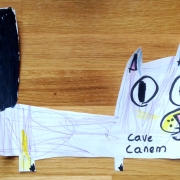Mythical Kings and Iguanas
Looking down towards Ledbury and the countryside beyond, on a bright Autumn morning when nobody is about, and the serene landscape looks like it would rather just stay in bed and wait for next Spring, it is hard to believe anything momentous has ever taken place in such a pastoral setting, until you picture Caratacus fighting the Romans at British Camp in the first century AD, or the Battle of Ledbury in 1645, or you acknowledge the influential legacy of the Dymock poets and John Masefield, or the music of Elgar, or you remember the bold but unsuccessful experiment of the Chartist settlement of 1848. All this in such a small patch of land.
I know this is a ceramics blog, dear Reader, but Man’s capacity to do good and bad is in the news, the latter tendency reinforced in your mind as you enter Frith wood and imagine Nature fierce in tooth and claw: ferrets killing fledglings, foxes eating rabbits, badgers snacking on frogs. On the other hand, bees and ants are pretty good at organising societies and generally minding their own. Just like the Chartists.
However, unlike ants, bees and other insects, the Chartists focused on the six points of the People’s Charter, which aimed to introduce universal male franchise (at a time when perhaps only one-fifth of adult males had the vote – essentially those drawn from the upper and middle classes) and a more equitable and democratic political system.
Yes, the Chartists provide us with the ceramic link for this blog, because not only did they experiment with their settlement near Ledbury, but rose in protest at Newtown, Wales, in 1839, which is where Peter Arscott Ceramics can be seen at the Oriel Davis Gallery.
Newtown is the birthplace of a remarkable man. Robert Owen was a self-made man, reformer, philanthropist, community builder who spent his life seeking to improve the lives of the working class. He improved working conditions for factory workers, which he demonstrated at New Lanark, Scotland, became a leader in trade unionism, promoted social equality through his experimental Utopian communities, and supported the passage of child labour laws and free education for children, as well as advocating for an eight-hour day. His principles became the basis for Britain’s Co-operative shops, some of which continue trading in altered forms to this day. There is a museum dedicated to his life in the town.
Owen was a “Utopian Socialist”, as Marx and Engels called him. They argued that his plan, to create a model socialist utopia, was insufficient to create a new society. In their view, it was utopian because the overthrow of the capitalist system could only occur once the working class was organized into a revolutionary socialist political party that was completely independent of all capitalist class influence. Anyway, I’ve always wanted to insert Marx’s image into this blog, so here goes.
Spiro (in charge of Marketing and Communications) says “too much history! Enough!”, so back to Frith Wood, albeit briefly. There was a golden light slanting in through the trees and the fallen leaves provided a carpet of gold, green, purple and ochre colours to walk on. Other than that, there was no flora to see except the occasional scattering of Hypholoma fasciculare, commonly known as the sulphur tuft or clustered wood lover, a common woodland mushroom, often in evidence when hardly any other mushrooms are to be found.
The sulphur tuft grows prolifically in large clumps on stumps, dead roots or rotting trunks of broadleaved trees. It looks inviting enough, but is treacherous, bitter and poisonous, and consuming it can cause vomiting, diarrhoea and convulsions. In contrast, a lovely feeling of serenity, peace and general satisfaction will envelop you when you visit the Oriel Davies Gallery. It is a key public art gallery of Wales, presenting world-class, thought-provoking and challenging art by national and international artists in an environment that is welcoming (and free). Its shop sells Peter Arscott ceramics, and it has a good café too.
On arrival to deliver the ceramics, there was a busker singing in the town centre. Unusually, because it’s nearly always Bob Dylan, the Beatles or Leonard Cohen, this lady was singing Dory Previn’s Mythical Kings and Iguanas, a song that might take your mind back if you are of a certain age. As far as I know, Dory has no connections to Newtown (she was born in New Jersey) but listen to her on the Old Grey Whistle Test by clicking here.
Spiro says that not one of the team at Peter Arscott Ceramics has ever flown to star-stained heights on bend and battered wings, like Dory. But Spiro, being a third century Bishop of Trimythous, is somewhat literal in his interpretations and there is no way he understands metaphor or allegory, though ironically, Thelonious, perhaps because he is a heavy cast iron and earth-bound pugmill, understands fully. He has the heart of a poet.

















